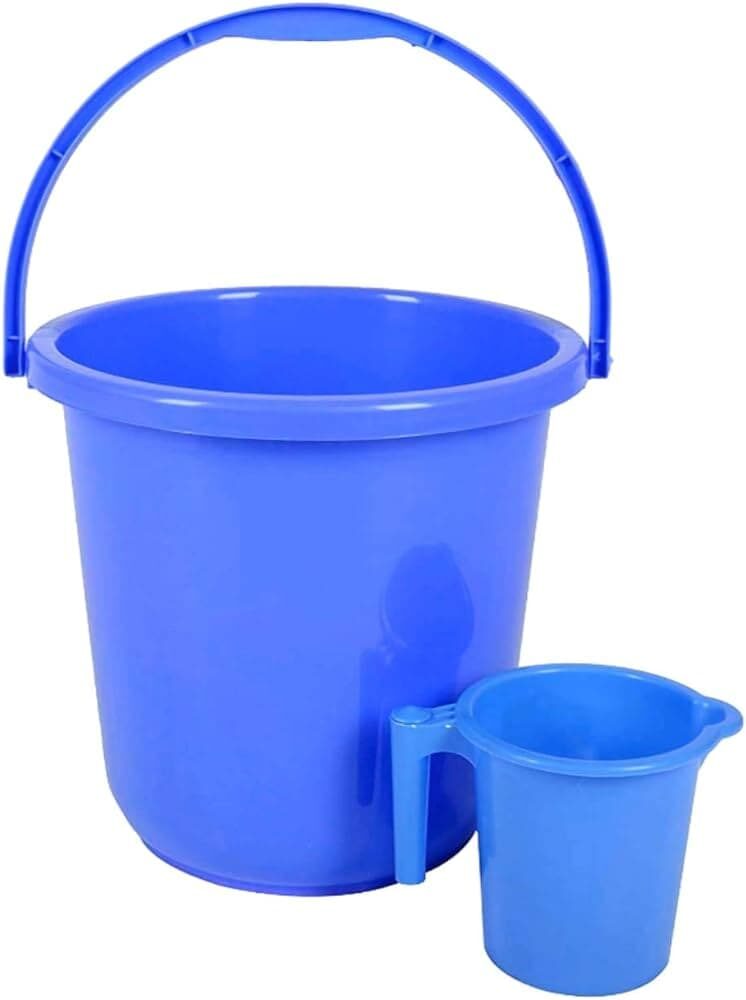Recently, my apartment building did not have heat or hot water for several days because of a steam pipe blast on my street. Although it was winter, the weather was relatively mild, and a space heater and fleece jacket were enough to get by. I remembered the Bennet sisters from Little Women warming their beds in winter with hot water bottles; that was an option if the cold got worse.
While the heat situation seemed under control, my friends asked, “How will you shower with cold water?” “No problem,” I replied, “I have a bucket.” A plastic bucket and mug (like a measuring cup) are essential to every Indian’s bathroom, and many of us continue with the tradition. I filled the bucket with 3/4ths of cold tap water and 1/4ths of boiling water from a kettle, and the bath was ready.
One of my comedy acquaintances couldn’t believe Indian American comic Zarna Garg’s bit about how your bath in India ended when your bucket was empty. That was my situation now, and the body, used to the long hot showers, craved the extended heat but soon adjusted. I could thrive for days with my trusted bucket and mug. The steam pipe blast was also a trip down memory lane, both sweet and sour. Overhead showers were uncommon when I was growing up; it was a Western tradition, and only fancy homes had them. We used buckets to bathe. We filled our buckets with water from the tap and used the mug to scoop the water to rinse ourselves. We chose our buckets and mugs like kids have their favorite coffee mugs. I always went for the brightest-colored buckets and flower-patterned mugs.
It was too hot to need warm baths, and water was plentiful in my home state, Kerala. Although the elders disapproved of the excess, you could indulge in long baths with multiple bucket refills. Once, I was visiting my grandmother. Her house had no elaborate plumbing, and the bath water drained into her backyard. During one of my particularly long baths, my father angrily knocked at the bathroom door, asking me to stop. It turned out my bathwater was more than the backyard could hold, and it was running onto the front yard, in plain sight of some guests sitting on the porch.
When I moved to the Indian city, Chennai, notorious for its water shortages, I realized buckets are life savers. Two large buckets with lids were an essential part of the move-in gear—one for the kitchen and one for the bathroom. Water supply was restricted to certain hours of the day, usually early morning. Your day started on a good note if you could take a bath during this time and then also fill the buckets to the brim. Chennai also brings back painful memories of seeing long lines of people (without indoor plumbing) waiting for their turn to fill their buckets from the public taps. The frustrating wait in the sweltering heat for your limited water ration meant that tempers ran high. Street brawls over cutting the line or taking more than your rightful share of water were common. Most of these people had to make do with one bucketful of water, and baths took a backseat. Chennai has a custom of women wearing the fragrant jasmine flowers on their hair every day; rumor has it that this tradition began to mask the stench of their unwashed bodies (just as it is rumored that the French invented perfumes to mask their lax personal hygiene).
Although the bucket and mug are inseparable companions, the mug is surprisingly versatile by itself. When I was young, long-distance journeys were mostly by train (millions of Indians still do). The train toilets had steel mugs chained to the wall, so you don’t steal them. But no one used these filthy mugs and instead carried their own. The mugs also doubled up as toiletry bags; they held your toothbrush, toothpaste, creams, and soap. If you took an overnight train, you woke up to see people lined up with their mugs to brush their teeth at the train’s wash basin. Speaking of train journeys, watching the sunrise from the train included seeing people carrying their mugs of water to find a private spot for their morning ablutions. I particularly dreaded crossing over to the water-scarce state of Tamil Nadu in the mornings because the extent of open defecation hit hard.
On a lighter note, I took my father on a trip to New Delhi to visit our cousins ten years back. We were flying, but my father had not traveled long distances in decades and only remembered his preparations for a three-day train journey. I saw him meticulously pack his travel “mug” with his toiletries. He would not relent when I reminded him it was only a three-hour flight and that our cousins would have soap and toothpaste. He even slipped a small piece of washing soap into his mug. While we were unpacking our bags at my cousins, my father suddenly burst into tears. He’d forgotten to pack his painstakingly stocked mug. He calmed down when I took him to our bathroom and showed him it was well-stocked with toiletries. But he still mumbled that with this kind of forgetfulness, he would never travel again. Sadly, it proved prophetic because he passed away soon after our trip.
I didn’t really “need” a bucket in the US, and over the years, I kicked the habit. I recently bought a foldable bucket to soak my feet, which proved invaluable during the steam pipe burst. The incident also reminded me that people who grow up in cultures of scarcity are ingenious in adapting to crises. I often tell my students that climate change-related problems like power outages will be harder on those who have never experienced them.
It is good to have some basic survival skills. Put that bucket on the shopping list.


